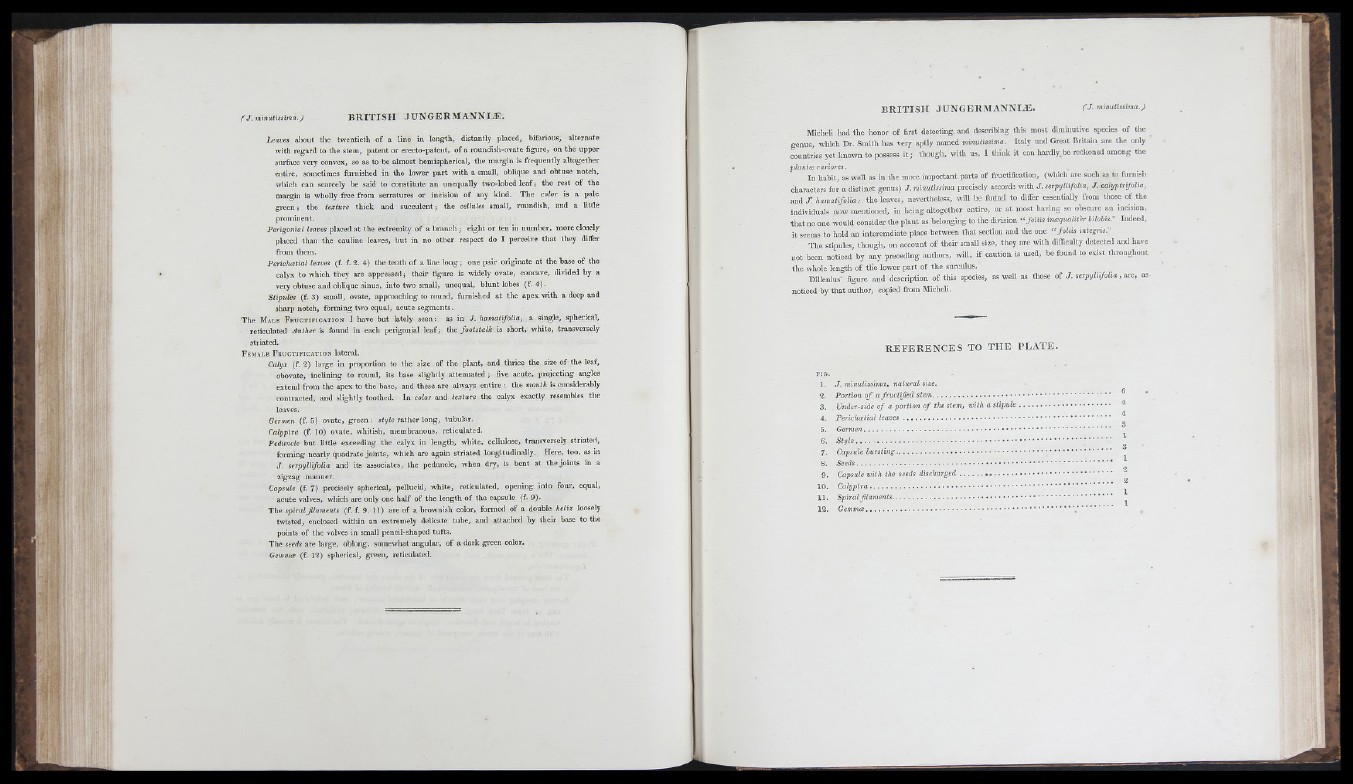
Leaves about the twentieth o f a lin e in len g th , distantly placed, bifarious, alte rna te
with regard to the stem, pa tent or erecto-patent, o f a roundish-ovate figure, on th e upper
surface very convex, so as to be almost hemispherical, th e margin is frequently altogether
entire, sometimes furnished in the lower p a r t with a small, oblique and obtuse notch,
which can scarcely be said to constitute an unequally two-lobed le a f; th e re st o f th e
margin is wholly free from serratures o r incision o f any kind. T h e color is a pale
g r e e n ; th e texture thick and succulent; th e cellules small, roundish, and a little
prominent.
Perigonial leai’es placed a t th e extremity o f a branch ; e ig h t o r ten in n um be r, more closely
placed than th e cauline leaves, b u t in no otlier respect do I perceive th a t they differ
from them.
Perichætial leaves (f. f. 2. 4) the tenth o f a line lo n g ; one p a ir originate a t the base o f the
calyx to which they are ap p re s s a l; the ir figure is widely ovate, concave, divided by a
very obtuse and oblique sinus, into two small, unequal, b lu n t lobes (f. 4).
Stipules (f. 3 ) small, ovate, approaching to round, furnished a t th e apex with a deep and
sharp notch, forming two equal, acute segments.
The. Male F ructification Î have b ut lately seen: as in J . hamatifolia, a single, spherical,
reticulated A nther is found in each perigonial le a f; th e fo o ts ta lk is short, white , transversely
striated.
F emale Fructification lateral.
Calyx (f. 2) la rge in proportion to th e size o f th e p lant, and thric e th e size o f th e leaf,
obovate, inclining to round, its base slightly a ttenuated ; five acute, prqjectiug angles
extend from the apex to th e base, and these are always entire ; th e mouth is considerably
contracted, and slightly toothed. In color and texture the calyx exactly resembles the
leaves.
Germen ( f .5 ) ovate, g re e n : sfyfe ra th e r long, tu b u la r.
Calyptra (f. 10) ovate, whitish, membranous, reticulated.
Peduncle but little exceeding the calyx in len g th , white, cellulose, transversely striateil,
forming nearly quadrate jo in ts , which are again striated longitudinally. Here, too, as in
J. serpyllifolia and its associates, the peduncle, when d iy, is bent a t th e joints in a
zigzag manner.
Capsule (f. 7 ) precisely spherical, pellucid, w h ite , reticulated, opening in to four, equal,
a cu te valves, which are only one ha lf o f the len g th o f the capsule (f. 9).
T h e spiral filaments (f. f. 9. 11) are of a brownish color, formed of a double helix loosely
twisted, enclosed within an extremely delicate tube , and a ttached by the ir base to the
points o f th e valves in small pencil-shaped tufts.
T h e seeds are large, oblong, somewhat angula r, o f a dark green color.
Gemmæ (f. 12) spherical, gre en, reticulated.
MichcU had th e honor o f first detecting and describing this most diminutive species o f the
genns, which Dr. Sm ith has very ap tly named m a a lis iim a . Italy and Great Britain are th e only
countries yet known to possess I t ; th o u g h , with u s, I th in k i t can hardly.be reckoned among the
plantæ rariores.
In h ab it, as well as in the more imp o rtan t parts o f fructification, (which are such as to furnish
characters for a d istinc t genus) J . m im lissima precisely accords with J. serpyllifolia, J . calyptrifoUa,
and f . h am atifolia: th e leaves, nevertheless, will be found to dlfler essenliafiy from those of th e
individuals now mentioned, in b e ing altoge the r entire , o r a t most having so obscure an incision,
th a t no one would consider th e p lan t as belonging to th e division ••foliis im q u a litc r iiloMs.’' Indeed,
it seems to hold an interemdiate place between th a t section and the one • •fo liis integris."
T h e stipules, th o u g h , on account o f the ir smafi size, they are w ith difficulty detected and have
n ot be en noticed by any preceding authors, will, if c antinn is used, be found to exist th roughout
th e whole len g th of th e lower p a rt o f th e surculus.
Dillenius' figure and description o f this species, as well as those of J . serpylUfoha ,a r e , as
noticed by th a t author, copied from Micheli.
R E F E R E N C E S T O T H E P L A T E .
1 . J . minutissima, natural size.
2. Portion o f a fructified stem.................................................................................................... ^
S. U n d e rsid e o f a portion o f the stem, with a s tip u le ................................................... *
4. PerichfEtial le a v e s ..................................................................................................................... 2
5. Germen............................................................................................................................................
6. S ty le .................................................................................................................................. *
7. Capsule bursting..........................................................................................................................
8. Se eds.................................................................................................................................. J
9. Capsule with the seeds disch a rg ed ..........................................................................................
10. Ca lyp tra ................................................................................................................. ^
11. Sp ira l filaments............................................................................................................................. ^
12. .................